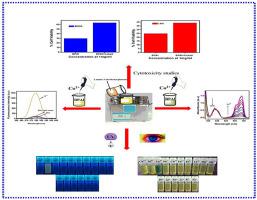Journal of Luminescence ( IF 3.6 ) Pub Date : 2021-07-31 , DOI: 10.1016/j.jlumin.2021.118359 J. Jone Celestina 1 , P. Tharmaraj 1 , C.D. Sheela 2 , J. Shakina 3

|
A novel and highly selective fluorescent optical sensor developed from 9-anthracene carboxaldehyde and 2-amino 5-nitro benzophenone (BPAI) was designed and synthesized by ultrasonication for rapid Co2+ detection in ethanol medium by charge transfer and CHEF (Chelation Enhanced Fluorescence) mechanism. The stoichiometry of the complexation was calculated as 1:1 via Job's plot and confirmed by mass spectrum. The structure of both the ligand and the metal complex was confirmed by UV, FT-IR, NMR and mass spectral studies. The mechanism of sensing was observed through experimental calculations. Upon treatment of various metal cations such as Cu2+, Ni2+, Zn2+, Cr3+, Mg2+, Hg2+, Fe2+, Fe3+, Cd2+, Pb2+,Al3+, Pd2+, K+, Na+,As3+ no noticeable changes were observed in both absorbance and fluorescence spectral measurements except that of Co2+. The absorbance of BPAI + Co2+ exhibited two new peaks at 616 nm and 679 nm. The fluorescence response of BPAI at 580 nm was abruptly increased, accompanied by the colour change of the BPAI with Co2+ compared to BPAI. The color change from pale brown to yellow occurred due to the binding of Co2+ with that of BPAI thereby yielding a fluorescence-enhanced product. BPAI exhibited significant selectivity within short response time and strong charge transfer mechanism due to the chelation process. The detection limit was found to be 0.00091 μM which is much lower than the permissible limit recommended by WHO. Real sample analysis was performed for the practical applicability of BPAI in the environment. Furthermore, BPAI can be used as a colorimetric and fluorescent sensor to detect Co2+ in biological environments, demonstrating its low cytotoxicity using MTT assay by MG63 cells and L929 cells.
中文翻译:

用于细胞毒性研究和实际样品分析的基于蒽的选择性 Co (II) 比色和荧光传感器
设计并合成了一种由 9-蒽甲醛和 2-氨基 5-硝基二苯甲酮 (BPAI) 开发的新型高选择性荧光光学传感器,通过超声处理通过电荷转移和 CHEF(螯合增强荧光)快速检测乙醇介质中的Co 2+机制。络合的化学计量通过乔布斯图计算为 1:1,并通过质谱确认。配体和金属配合物的结构均通过 UV、FT-IR、NMR 和质谱研究证实。通过实验计算观察了传感机制。处理各种金属阳离子如Cu 2+、Ni 2+、Zn 2+、Cr 3+、Mg 2+、Hg2+ , Fe 2+ , Fe 3+ , Cd 2+ , Pb 2+ ,Al 3+ , Pd 2+ , K + , Na + ,As 3+在吸光度和荧光光谱测量中没有观察到明显的变化,除了Co 2+。BPAI + Co 2+的吸光度在616 nm 和679 nm 处出现了两个新峰。与 BPAI 相比,BPAI 在 580 nm 处的荧光响应突然增加,伴随着带有 Co 2+的 BPAI 的颜色变化。由于Co 2+的结合,颜色由浅棕色变为黄色与 BPAI 相结合,从而产生荧光增强的产物。由于螯合过程,BPAI 在短响应时间内表现出显着的选择性和强大的电荷转移机制。发现检测限为 0.00091 μM,远低于 WHO 推荐的允许限值。对 BPAI 在环境中的实际适用性进行了实际样品分析。此外,BPAI 可用作比色和荧光传感器来检测生物环境中的Co 2+ ,在 MG63 细胞和 L929 细胞的 MTT 测定中证明其低细胞毒性。



























 京公网安备 11010802027423号
京公网安备 11010802027423号